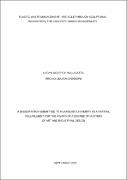| dc.contributor.author | Nsalasatta, Lugya Godfrey | |
| dc.date.accessioned | 2023-02-07T10:55:35Z | |
| dc.date.available | 2023-02-07T10:55:35Z | |
| dc.date.issued | 2022-09 | |
| dc.identifier.citation | Nsalasatta, Lugya Godfrey(2022) Plastic waste management - recycle through sculptural innovation: the case for Iganga municipality | en_US |
| dc.identifier.uri | https://hdl.handle.net/20.500.12504/1196 | |
| dc.description | xiii,79p.:ill (some col) | en_US |
| dc.description.abstract | This Study was intended to demonstrate how well solid waste can be turned into usable
materials through a process called recycling. The recycled material can then be used as
source of income for the workforce involved in beautifying the compounds, sitting rooms,
designing areas for tourism attractions, and other major uses. This study explored
possibilities of manipulating plastic waste (pet bottles and polythene bags) to produce
sculptural art forms in order to promote plastic waste mitigation. The objectives of the study
were : (i) to assess the effectiveness of plastic waste management in Iganga Municipality;
(ii)to analyze the physical properties of plastic waste damped in Iganga Municipality; (iii) To
explore studio-based means of manipulating plastic waste for sculpture production and (iv)
to produce prototypes of sculptures from selected plastic waste in Iganga Municipality.
The study employed qualitative and studio –based sculptural methods. Data collection tools
included questionnaire, observation, photography, interviews and studio explorations. During
the studio exploration materials were woven together using plastic threads with interlacing of
bottle seals to produce ropes of various impressions. These were assembled to form a variety
of sculpture forms.
The study revealed that most household respondents use plastic bags to store plastic waste.
And that burning (incineration) was a common method of disposal within households.
Recycling was done by a few manufacturers because it was considered expensive. The study
also confirmed that the existing policy on plastics (ban on polythene bags thinner than 30
microns) lacks implementation. It was revealed that there was no statistically significant
association between the methods of plastic disposal and other variables. It was established
that most waste collectors have a negative attitude towards plastic waste collection because
they earn little income from it. The study revealed that most households carelessly throw
plastics away and that they end up on the streets, drainage channels and the lake despite the
government's ban on the use of plastic bags. Consequently, there is continuous circulation of
polythene bags and other plastics within the municipality. The study revealed that most of the
stakeholders are not willing to sort plastics from waste. The municipality has no clear plastic
waste management strategy. The study revealed that plastic waste management practices in
Iganga are still ineffective, and this is attributed to a lack of implementation of government
policy and legislation on plastic waste. There is a need to sensitize the public about the
environmental damage caused by plastics. Artists have a role to play through sculptural
innovations. The findings of this thesis will help artists to learn new skills of plastic waste
manipulation. The studio exploration revealed that art, and in particular sculpture, can be
developed from plastic waste. This provides an opportunity for municipal councils to
sensitize the community about the prospects that art presents in the fight against plastic waste
pollution within their communities. | en_US |
| dc.language.iso | en | en_US |
| dc.publisher | Kyambogo University[unpublished work] | en_US |
| dc.subject | Plastic waste management. | en_US |
| dc.subject | Sculptural innovation. | en_US |
| dc.subject | Recycle through. | en_US |
| dc.title | Plastic waste management - recycle through sculptural innovation: the case for Iganga municipality | en_US |
| dc.type | Thesis | en_US |

